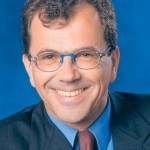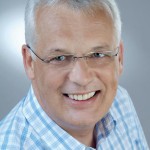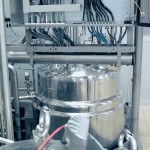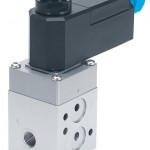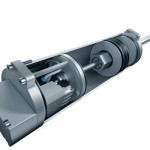Festo has been a constant and global player in factory automation for many years. Since 2006, the company has increased its investments in the development of products and complete systems for the process industry. In 2007, Festo’s turnover from process industry customers was more than hundred million Euro. We discussed Festo’s targets and its main development focus for process automation with Dr.-Ing. Eckhard Roos, Head of Process Automation and Thomas Zeuch, Head of Process Application Management.
cpp: Process automation is one of the strategic business segments for the future at Festo. What are the company’s targets for this sector and what have you already achieved?
Dr. Roos: Festo has been committed to the process automation sector (PA) since 2003 and a revised business plan for this was approved in 2006. Since then, we have pushed up investment and have taken on many people from the process automation sector as they have the appropriate expertise. Growth rates in process automation are currently above the overall growth rates for the company and above the market growth rates. Increasing value for customers is firmly established in our PA strategy. By focussing on the target and implementing the necessary actions in development, manufacturing, logistics and market development, we will be able to achieve the ambitious turnover target.
cpp: What do you expect turnover to be in the process automation sector?
Dr. Roos: In 2007, growth was a low two-digit figure compared to 2006, with turnover being more than 100 million Euro. For 2010 and onwards, however, we have much higher expectations. This is mainly because we currently generate our turnover on the basis of available products and a strong market penetration, while from 2009 or 2010 we will approach the market with new products and develop new segments, which previously have not been accessible to us.
cpp: Which industry segments do you want to concentrate on in particular in future?
Zeuch: We have been dealing with new industry segments within process automation since 2006. These include, among others, biotech/pharma, chemicals, petrochemicals, oil & gas, the food industry and water/wastewater. At the same time, we are searching for solutions that generate value for the customer. Because Festo’s traditional strength is in the field of pneumatics, we are of course trying to create synergies so we can introduce pneumatic components into the automation chain.
cpp: Why does a company known for its pneumatic products and one of the market leaders in this field, want to get into a sector that is very different to factory automation?
Dr. Roos: Globally, there will be a change in the markets; the forecasts for market growth in the PA sector are significantly higher in percentage terms than those for factory automation (FA), and also at a significantly higher absolute level. Through its strategic commitment to PA, Festo has created a solid basis for achieving a major increase in turnover in this new market segment. A fundamental factor for success is the full utilisation of possible synergies along the entire value creation chain. In addition to synergies on a product level, this also includes potential in develop-ment, manufacturing, global logistics and of course in marketing, where access to existing customers in the FA area, for example especially in hybrid industries, will also open doors for us in the PA area.
cpp: In your view, what are the main differences between the two worlds of process and factory automation?
Zeuch: When you consider the requirements of these sectors, they are very different indeed. In factory automation, most systems are indoor ones designed for speed, throughput, fast movements and transport of heavy loads from one point to another, so further production steps can be performed at a different workstation.
In process automation the requirements are completely different. Systems often cover a large area and are in outdoor environment, i. e. exposed to varying weather conditions. A further big difference is explosion protection, which must be taken into account in many systems, and also Food and Drug Administration (FDA) and GAMP requirements. In other words, systems for process automation are not so much geared to speed and minimising costs as factory automation, but much more to safety, as the consequences in the event of a fault can be considerably greater.
cpp: What is the current status of your main areas of development? Can synergies from automated manufacturing be used?
Dr. Roos: We mainly see synergies in the products and solutions that we are introducing into factory automation at present. These products are in part ready for applications in process automation. Take, for example, our quarter turn actuators and valve terminals. There are also systems in process automation where a multitude of pneumatic consuming devices have to be fitted in a small space. For all such requirement characteristics, plant managers will find the valve terminal solution a more attrac-tive alternative to using individual valves as it is financially advantageous and offers better options. In other words, valve terminals can be easily transferred from factory automation to other systems with the same requirements. These are essentialy installations in the bio/pharma and fine chemicals segments, i. e. mostly indoor systems. There are no stipulations in terms of possible temperature fluctuations and explosion protection and the consuming devices have the same characteristics. At the same time, we have initiated developments to close the gaps in our existing product portfolio, e. g. in relation to explosion protection. In addition to synergies in product development, we are also able to use existing test facilities and our international logistics and service structure. Globally operating process automation customers also demand global suppliers who can offer the appropriate co-ordination and services.
cpp: In autumn 2008, Festo will introduce directly and indirectly actuated individual valves for outdoor applications on the market. Can you tell us more about the specifications for these new developments?
Zeuch: The sturdy design of the pilot valves VOFC/VOFD means they are very reliable and can be used in harsh outdoor environments. The typical application for this valve is as a pilot valve for actuators operating e. g. butterfly valves in chemical and petrochemical installations. Both the directly and indirectly actuated pilot valves are available with a flanged connection in accordance with Namur. Compared to the classic piping connector of the pilot valve to the actuator, the valves can be connected directly to the actuator via this interface. This reduces technical hazards and installation time. This interface is standardised for connecting control valves to valve actuators as per the VDI/VDE 3845 standard. In case of hazardous atmospheres, which are often present in installations, the armature guide tube of the valves can be combined with suitable solenoids in every case and thus adapted as necessary. The sturdy poppet valve principle and high flow rates, especially in the exhaust duct, make directly actuated 3/2-way valves quick and reliable. Therefore, they are very often used for emergency shutdown circuits. The function of these circuits is to open or close the appropriate butterfly valves as quickly as possible in an emergency.
cpp: Are further product innovations still to be expected this year?
Dr. Roos: In addition to the VOFC/VOFD valves we will introduce a controlled, sturdy linear actuator with integrated positioner and displacement encoder in a compact design, the DFPI. All functionalities are integrated within the same housing. Commissioning this system is extremely simple, i. e. using the Plug & Play concept. The market release for this is end 2008. Then, at the start of 2009, we will be launching a series of sensor boxes on the market, to complement the actuator package from a single source and of our own manufacture.
cpp 449
Mehr zu den VOFC/VOFD-Ventilen
CPX/MPA-Ventilinsel mit Diagnosefunktion
DFPI Geregelter Linearantrieb
Share:



